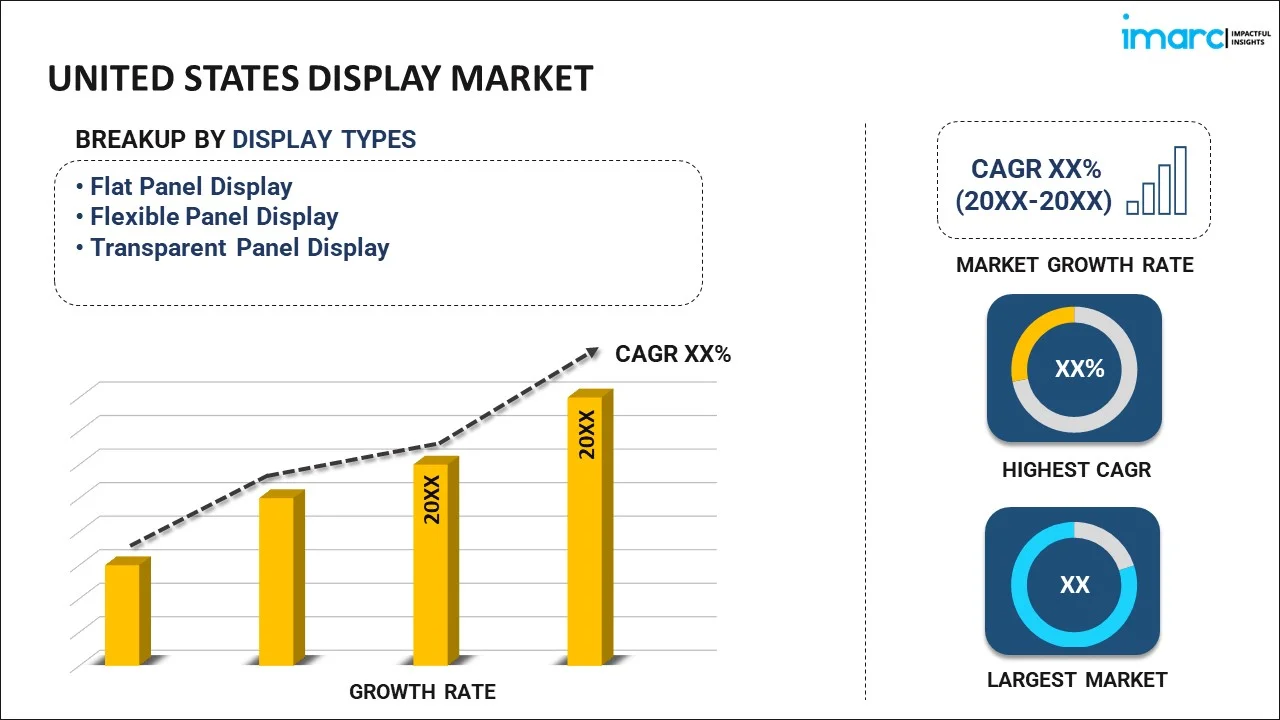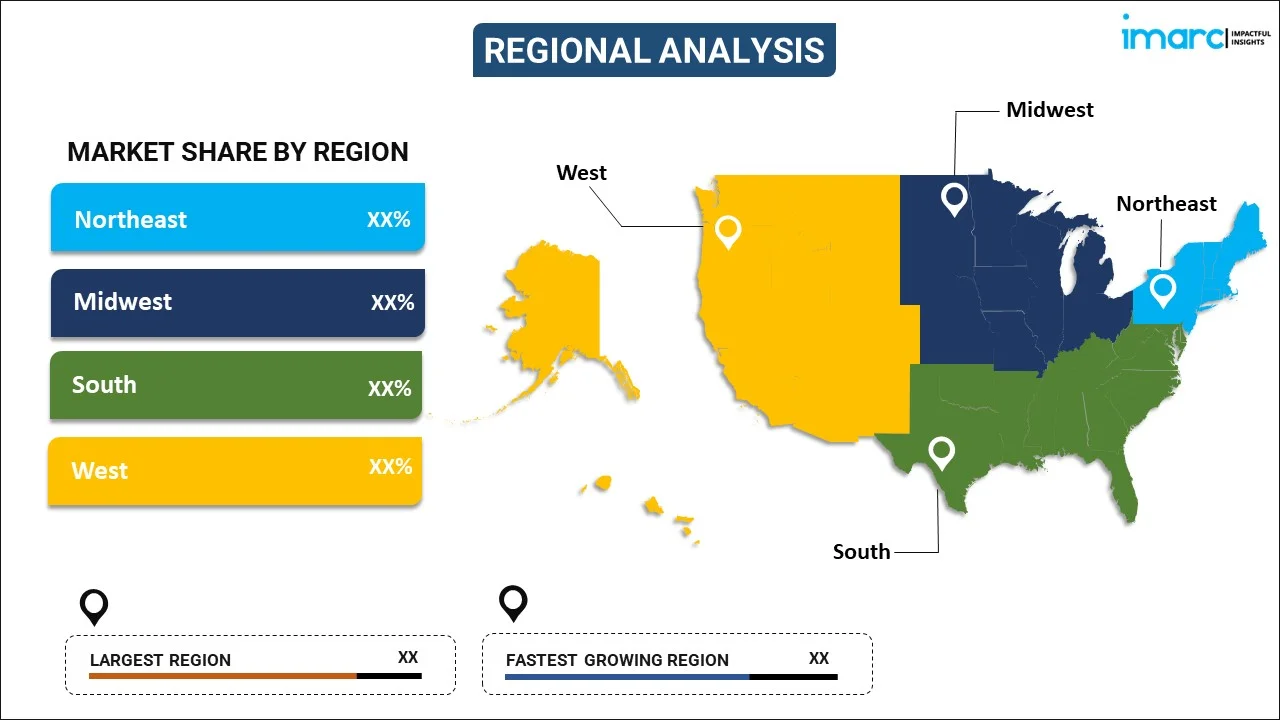
United States Display Market Report by Display Type (Flat Panel Display, Flexible Panel Display, Transparent Panel Display), Technology (OLED, Quantum Dot, LED, LCD, E-paper, and Others), Application (Smartphone and Tablet, Smart Wearable, Television and Digital Signage, PC and Laptop, Vehicle Display, and Others), Industry Vertical (BFSI, Retail, Healthcare, Consumer Electronics, Military and Defense, Automotive, and Others), and Region 2025-2033
Market Overview:
The United States display market size reached USD 42.0 Billion in 2024. Looking forward, IMARC Group expects the market to reach USD 54.2 Billion by 2033, exhibiting a growth rate (CAGR) of 2.76% during 2025-2033. The increasing adoption of advanced display technologies across various industries, the proliferation of smartphones, tablets, wearables, and smart home devices, and the robust economic growth and increased disposable income levels are some of the key factors driving the market.
|
Report Attribute
|
Key Statistics
|
|---|---|
|
Base Year
|
2024
|
|
Forecast Years
|
2025-2033
|
|
Historical Years
|
2019-2024
|
|
Market Size in 2024
|
USD 42.0 Billion |
|
Market Forecast in 2033
|
USD 54.2 Billion |
| Market Growth Rate 2025-2033 | 2.76% |
United States Display Market Analysis:
- Major Market Drivers: Rising consumer demand for high-definition, interactive displays across industries fuels the United States display market growth. Advanced technologies including OLED, LED, and microLED adoption in smartphones, gaming, and automotive sectors drive market expansion. Digital transformation initiatives across healthcare, retail, and education verticals significantly boost display technology investments and market penetration nationwide.
- Key Market Trends: Increasing preference for larger screen sizes, flexible and transparent displays characterizes current market dynamics. The market share shifts toward energy-efficient, sustainable display solutions. AR/VR integration, touch-enabled interfaces, and IoT-connected smart displays emerge as dominant trends reshaping consumer expectations and industrial applications across multiple sectors.
- Competitive Landscape: Market consolidation intensifies as leading manufacturers focus on technological innovation and strategic partnerships. The United States display market analysis reveals competitive positioning through R&D investments in next-generation technologies. Companies leverage vertical integration, supply chain optimization, and customization capabilities to maintain competitive advantages in this rapidly evolving industry.
- Challenges and Opportunities: Supply chain disruptions and raw material costs present ongoing challenges while environmental sustainability requirements drive innovation. The market size expansion creates opportunities in emerging applications including automotive displays, smart infrastructure, and wearable technologies. Miniaturization trends and power efficiency improvements unlock new market segments and applications.
Display refers to the visual output or presentation of information, data, or images on a screen or surface for human observation. It is a critical component of various electronic devices, such as computers, smartphones, televisions, and digital signage, as it allows users to interact with and perceive information in a meaningful way. Displays come in various technologies, including Liquid Crystal Display (LCD), Light Emitting Diode (LED), and Organic Light Emitting Diode (OLED). Higher resolution displays offer crisper and more detailed images, while accurate color reproduction ensures lifelike visuals. A faster refresh rate provides smoother motion, which is crucial for activities, including gaming and video playback. Moreover, brightness plays a vital role in readability and usability under different lighting conditions. With the advent of touchscreen technology, displays have become more interactive, enabling users to directly interact with the displayed content using gestures and touches.
United States Display Market Trends:
Innovation in Flexible and Wearable Displays
The US display market is becoming more driven by advancements in flexible and wearable display technologies. Foldable displays, rollable displays, and bendable OLED panels are becoming popular in smartphones, smartwatches, and other wearable products, providing for tiny form factors without sacrificing image quality. These technologies appeal to consumers looking for portability, increased interactivity, and rich user experiences. Furthermore, research on lightweight, low-power displays has found interest in healthcare and fitness markets, where wearables depend on crisp, resilient screens. Industry players are investing in new materials, miniaturization methods, and resilience testing to satisfy changing user needs. As demand increases, the use of these innovative displays is gaining speed, broadening product offerings and fueling growth in niche markets. This direction indicates a larger movement towards personalized, mobile-first experiences and serves to emphasize the industry's ability to adapt traditional display applications into revolutionary, user-driven solutions.
Sustainability and Energy-Efficient Display Adoption
Environmental concerns are emerging as a prime driver in the United States display market. Businesses and consumers alike more and more want energy-efficient displays with smaller carbon footprints, like OLED, MiniLED, and quantum dot screens, that run more efficiently and offer better images. As a response, manufacturers are adapting with eco-friendly manufacturing processes, recycling initiatives, and green materials to match regulatory and consumer demands. Public organizations and business consumers are giving preference to screens that have energy certifications in order to minimize operational expenses and environmental footprints. Furthermore, the increasing level of awareness regarding electronic waste disposal is promoting investment in the more durable and recyclable components of the display. This transition to sustainable technology not only adds value to the brand of businesses but also helps expand markets. As energy efficiency becomes a common buying factor, eco-friendly innovations will lead adoption rates as well as overall growth in the display ecosystem.
Integration of Displays in Automotive and Smart Infrastructure
Displays are becoming more integrated into automobiles and intelligent infrastructure, fueling market diversification in the United States. Car dashboards, infotainment centers, and head-up displays are adding high-definition touchscreens, further empowering user engagement, navigation, and safety. At the same time, public areas, offices, and retail spaces are incorporating digital signage, interactive kiosks, and large-format displays for information distribution and engagement. The growth of smart city programs along with the increasing demand for connected cars has led to a rapid roll-out of integrated display solutions. The use involves robust, high-speed screens that can operate across varied environmental conditions. Companies are riding the wave by creating rugged, responsive displays apt for use in cars and outdoors. This intersection of transport, infrastructure, and display technologies enlarges the market pool but also encourages innovation so that displays continue to be at the center of contemporary digital experiences for many industries.
United States Display Market Segmentation:
IMARC Group provides an analysis of the key trends in each segment of the United States display market report, along with forecasts at the country level for 2025-2033. Our report has categorized the market based on display type, technology, application, and industry vertical.
Display Type Insights:

To get more information on this market, Request Sample
- Flat Panel Display
- Flexible Panel Display
- Transparent Panel Display
The report has provided a detailed breakup and analysis of the United States display market based on the display type. This includes flat panel display, flexible panel display, and transparent panel display.
Technology Insights:
- OLED
- Quantum Dot
- LED
- LCD
- E-paper
- Others
The report has provided a detailed breakup and analysis of the United States display market based on the technology. This includes OLED, quantum dot, LED, LCD, e-paper, and others.
Application Insights:
- Smartphone and Tablet
- Smart Wearable
- Television and Digital Signage
- PC and Laptop
- Vehicle Display
- Others
A detailed breakup and analysis of the United States display market based on the application has also been provided in the report. This includes smartphone and tablet, smart wearable, television and digital signage, pc and laptop, vehicle display, and others.
Industry Vertical Insights:
- BFSI
- Retail
- Healthcare
- Consumer Electronics
- Military and Defense
- Automotive
- Others
A detailed breakup and analysis of the United States display market based on the industry vertical has also been provided in the report. This includes BFSI, retail, healthcare, consumer electronics, military and defense, automotive, and others.
Regional Insights:

- Northeast
- Midwest
- South
- West
The report has also provided a comprehensive analysis of all the major regional markets, which include Northeast, Midwest, South, and West.
Competitive Landscape:
The report has also provided a comprehensive analysis of the competitive landscape in the market. Competitive analysis such as market structure, key player positioning, top winning strategies, competitive dashboard, and company evaluation quadrant has been covered in the report. Also, detailed profiles of all major companies have been provided.
United States Display Market News:
- September 2025: Meta launched its first consumer-ready smart glasses with a built-in display, the Meta Ray-Ban Display. Featuring notifications on the right lens and gesture-based controls, the device is designed to provide users with AI-driven “personal superintelligence” experiences.
- January 2025: Tianma showcased a wide range of advanced automotive display technologies at CES, including dual-screen multi-curved OLEDs, 3D instrument clusters, Mini-LED InvisiVue™, and Light Field 3D-HUD systems.
- December 2024: Apple is collaborating with Samsung Display and LG Display to develop a future iPhone featuring zero-bezel OLED technology and under-panel cameras, aiming for a full-screen immersive design while overcoming technical production challenges.
- January 2025: LG Display unveiled its fourth-generation OLED TV panel, optimized for the AI era. The panel features enhanced brightness, ultra-low reflection, and energy-efficient design, delivering superior picture quality, vivid colors, and human-friendly viewing experiences.
Report Coverage:
| Report Features | Details |
|---|---|
| Base Year of the Analysis | 2024 |
| Historical Period | 2019-2024 |
| Forecast Period | 2025-2033 |
| Units | Billion USD |
| Scope of the Report | Exploration of Historical and Forecast Trends, Industry Catalysts and Challenges, Segment-Wise Historical and Predictive Market Assessment:
|
| Display Types Covered | Flat Panel Display, Flexible Panel Display, Transparent Panel Display |
| Technologies Covered | OLED, Quantum Dot, LED, LCD, E-Paper, Others |
| Applications Covered | Smartphone and Tablet, Smart Wearable, Television and Digital Signage, PC and Laptop, Vehicle Display, Others |
| Industry Verticals Covered | BFSI, Retail, Healthcare, Consumer Electronics, Military and Defense, Automotive, Others |
| Regions Covered | Northeast, Midwest, South, West |
| Customization Scope | 10% Free Customization |
| Post-Sale Analyst Support | 10-12 Weeks |
| Delivery Format | PDF and Excel through Email (We can also provide the editable version of the report in PPT/Word format on special request) |
Key Benefits for Stakeholders:
- IMARC’s report offers a comprehensive quantitative analysis of various market segments, historical and current market trends, market forecasts, and dynamics of the United States display market from 2019-2033.
- The research study provides the latest information on the market drivers, challenges, and opportunities in the United States display market.
- Porter's five forces analysis assist stakeholders in assessing the impact of new entrants, competitive rivalry, supplier power, buyer power, and the threat of substitution. It helps stakeholders to analyze the level of competition within the United States display industry and its attractiveness.
- Competitive landscape allows stakeholders to understand their competitive environment and provides an insight into the current positions of key players in the market.
Key Questions Answered in This Report
The display market in United States was valued at USD 42.0 Billion in 2024, demonstrating substantial market presence and strong consumer demand across multiple industry verticals and technological applications.
The United States display market is projected to exhibit a CAGR of 2.76% during 2025-2033, reaching a value of USD 54.2 Billion by 2033 driven by technological advancement.
Key drivers include increasing adoption of advanced display technologies across industries, proliferation of smartphones and smart devices, digital transformation initiatives, robust economic growth, rising disposable incomes, and growing demand for high-definition interactive displays in entertainment and gaming sectors.
Need more help?
- Speak to our experienced analysts for insights on the current market scenarios.
- Include additional segments and countries to customize the report as per your requirement.
- Gain an unparalleled competitive advantage in your domain by understanding how to utilize the report and positively impacting your operations and revenue.
- For further assistance, please connect with our analysts.
 Request Customization
Request Customization
 Speak to an Analyst
Speak to an Analyst
 Request Brochure
Request Brochure
 Inquire Before Buying
Inquire Before Buying




.webp)




.webp)












